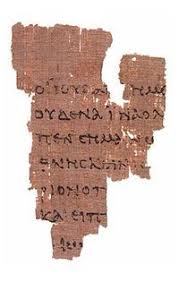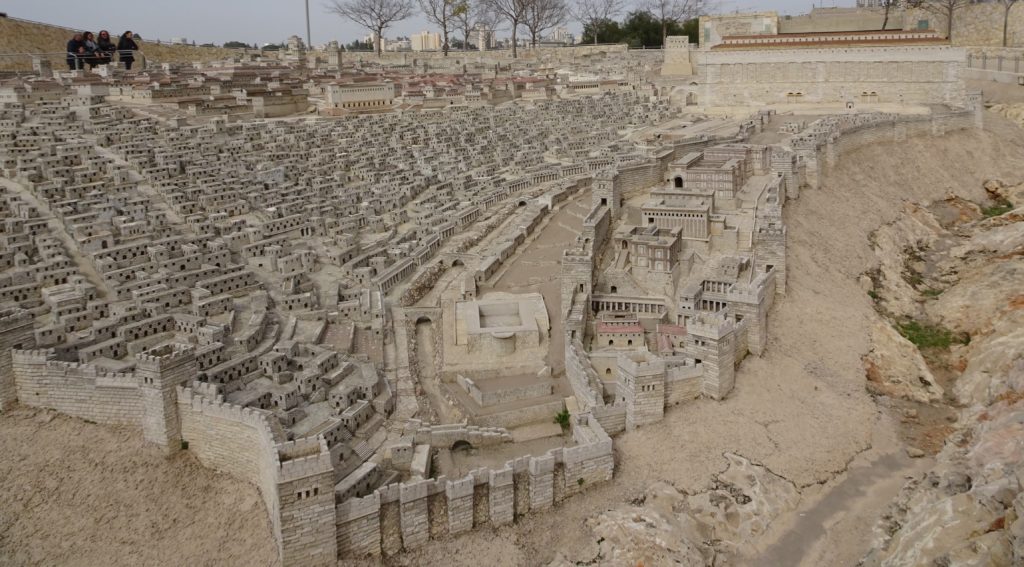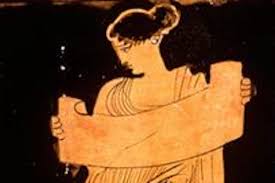THE PROBLEM(S)
From earliest times the gospel of John has been seen as different from the first three gospels. Irenaeus (130-202) called it “the spiritual gospel”. But what does that mean? Scholars’ opinions have varied wildly over the last 150 years, with the debate of ‘historical criticism’ being sparked off in the UK by the book “Essays and Reviews” in 1860.
a) When was it written?

Traditionally it was written at the end of John’s life, who died just before 100 AD. A hundred years ago many scholars put it sixty years or so later because it has such an “advanced” theology. Then in 1934 a fragment of the gospel was identified and dated by its writing to probably120 -150 AD, the earliest piece of the New Testament discovered. That meant it must have been written in the first century. John Robinson thought it was the earliest gospel to be written, about 60 AD.
b) Who wrote it?
Traditionally it was John son of Zebedee, one of the twelve apostles. He and his brother James were fishermen in Galilee in their family firm and were partners to Simon (Peter) and Andrew. He became one of the closest disciples to Jesus, accompanying him with Peter and James to the Mount of Transfiguration and Gethsemane. But if it was John bar Zebedee, why is it so different from the first three gospels? There was some confusion because there were two Johns whose tombs were in Ephesus: John the Apostle and John the Elder, but nothing was known about the latter. Recently it has been thought to be written for a small sect-like church, influenced by Gnosticism, and written over many years, reflecting the experience of the community. (See R E Brown “The Community of the Beloved Disciple”).
c) What sort of book is it?
Is it a biography of Jesus? In which case why is it so different from the first three gospels? Is it an attempt to introduce Gnostic thought into the early Christina movement? Bultmann (1884-1976) strongly argued for this.
(Gnosticism was a Jewish-Christian movement which thought that all matter is evil, only the non-material spirit-realm is good. It may have been a response to the utter destruction of Jerusalem in 68 AD. It used a lot of dualistic language like light versus darkness. Many texts, including the Gospel of Thomas, were discovered in a 4th century library at Nag Hammadi, Egypt in 1945. The First Letter of John attacks it). Or was it a defence against Gnosticism?
Was it influenced by Hermetic writings – a Greek-Egyptian pagan mystical movement of the 2nd – 4th centuries? Or is it basically Jewish? The discovery of the Dead Sea Scrolls in 1947 and 1951-56 showed that the dualistic language of light and darkness was thoroughly Jewish at the time, part of the Essene thinking (a first century quasi-monastic Jewish sect).
Confusing? You bet!
THE SOLUTION?
In Chapter 21 the author is identified as part of a group of Peter, Thomas, Nathanael, the two sons of Zebedee and two other unnamed disciples. So which one is John the gospel writer?
In his book “Testimony of the Beloved Disciple” (2007). Richard Bauckham, Professor of New Testament studies at Cambridge University, argues that the fourth gospel was written, not by the apostle John son of Zebedee from Galilee. Rather, it was written by a Jerusalem disciple whose name was also John – a common Jewish name. Immediately all sorts of things start to make sense. It explains why almost all the action takes place in Jerusalem. The first 20 chapters, apart from chapter 6, only have 22 verses which take place in Galilee!
He could easily have been a disciple of John the Baptist, whose ministry was in Judaea. (John 1.35-40)
He had the place of honour at the Last Supper, reclining on Jesus’ left. Perhaps he was the host and it was in his house. (John 13.23-25)
He was known to the High Priest. (John 18.15)
On the cross, Jesus says to him “Look, here is your mother”, and he took her into his home – in Jerusalem, not five days walk away in Galilee! (John19.26-27, 34-35)
Why “the disciple whom Jesus loved”? We are told that Jesus also loved Lazarus of Bethany. Could it be that it was because they were steadfast in their commitment to him, even though they lived in hostile Judaean territory rather than Galilee where Jesus was regarded as “their prophet”. (Mark 8.28, Luke 7.16)
The only argument against an early date is that Jewish Christians were being threatened by excommunication from the synagogue. This is said to have happened after the Jewish Council of Jamnia in 80 AD which settled the list of the Old Testament/Law and the Prophets/Tenach. Today this theory is “largely discredited”. After all, within 3 years of the crucifixion of Jesus, believers were being thrown into prison by the Jewish authorities!
WHAT SORT OF BOOK IS IT?
Richard Bauckham says that it follows the rules of historical biography in the ancient world.. These were:
a) Topography – the geographical descriptions had to be accurate.
John has 31 named places, 17 of which are unique to John and usually quite specific, i.e. not just in the Temple but in Solomon’s Portico. And his descriptions do fit exactly Jerusalem before its destruction in 70 AD, e.g. the Pool of Bethzatha with five porticoes (John 5.2), only understood after archaeologists unearthed it in 1964.

b) Eyewitness – the author had to be an eyewitness or to have talked to eyewitnesses;
John makes three claims to be an eyewitness: John 1.14, 19.34 and 21.24.
c) Selectivity – a biography was not the same as a history. The aim was not to record every episode, but to select only those ones which were significant or impressive, interspersed with varied subject matter. John’s eight miracles or signs contrasts with Mark’s and Luke’s eighteen, but this allows John greater freedom to be expansive and to comment on them in the discourses.
d) Discourses and dialogues – you had to include discourses because it was a highly rhetorical culture. The aim was to give the overall sense, but in your own style. John uses several devices to do this, conversations, solemn introductions, speeches:
i) Conversations.
Much of the gospel is taken up with conversation. For example more than half of chapter 7 is taken up comments by Jesus’ brothers, by the Jerusalem crowd and by the authorities. It gives a real flavour of what the word on the streets of Jerusalem was at that time.
ii) Amen, Amen
Whereas the first three gospels record Jesus as saying “Amen I say to you”, John always has him saying “Amen Amen I say to you.” Archbishop William Temple (1886-1944) believed that it reflected accurately how Jesus actually spoke. It is interesting that out of the 24 instances in John, about half would be at home in the synoptic gospels, e.g.
“No one can see the kingdom of God without being born from above.” (3.3)“Unless a grain of wheat falls into the ground and dies, it remains just a single grain; but if it dies, it bears much fruit.” (12.24) and “Slaves are not greater than their master, nor are messengers greater than the one who sent them.” (13.16)
iii) The ‘I am’ sayings
There are eleven “I am” sayings in chapters 6-15. To my surprise, only two are introduced by Jesus saying “Amen, Amen”. It is a style unlike the synoptic gospels, but he did claim extraordinary authority, such as redefining the Ten Commandments: ‘You have heard that it was said to those of ancient times, “You shall not murder”; and “whoever murders shall be liable to judgement.” But I say to you that if you are angry with a brother or sister, you will be liable to judgement…” (Matthew 5.21-22)
Perhaps the ‘I am’ sayings are John’s own summary of Jesus’ claims to authority. Or perhaps Jesus spoke differently in Jerusalem.
SOME QUESTIONS
What were John of Jerusalem’s relationships with the Twelve?
When did Jesus expel traders from the Temple? At the start or the end of his ministry?
Was he present at the feeding of the five thousand?
Is the raising of Lazarus from the dead historical?
Was he at the Last Supper? Why does he not mention the sharing of the bread and wine? And why do the final discourses seem repetitive?
The accompanying article gives a brief summary of the gospel chapter by chapter. There is a list of all the “Amen Amen” sayings, a list of the ‘I Am’ sayings, and some thoughts about the questions specified above. It will be found at

THE PURPOSE
John clearly states the purpose of the gospel in 20.31: “These are written so that you may believe that Jesus is the Messiah (Christ), the Son of God, and that through believing you may have life in his name.”
Straightforward, but there is a problem. “Believe” could mean “continue to believe” or “come to believe”, depending on whether the word in Greek has an ’s’ in the middle or not. C.K.Barrett wrote, “This verse does not enable us to answer the question whether he wrote for believers or unbelievers.”
The one sentence insertion into Jesus long prayer in chapter 17 would indicate that it was written for those outside the Christian community, “And this is eternal life, that they may know you, the only true God, and Jesus Christ who you have sent.” (17.3)
And the beginning of the gospel seems designed to appeal to anyone with a smattering of Hellenistic Jewish thought or Stoic philosophy. For example, in the 4th century Augustine, while still outside the faith, obtained “some of the books of the Platonists that had been translated from Greek into Latin. I found the Gospel wrapped up in them – not the exact words but the same meaning… “In the beginning was the Word, and the Word was with God, and the Word was God …” But that “the Word became flesh and dwelt among us”, that I failed to find in the works of the Platonists.” (Confessions 7.9)
CONCLUSION
I am happy to believe that the Gospel of John is a first-hand account of Jesus, particularly of his encounters in Jerusalem, while being worked up with considerable artistry by John of Jerusalem.
I now think it needs to be taken seriously alongside my favourite gospel, Mark. And that today, just as when it was first written, it provides a powerful witness to Jesus for both newcomers and long-term believers.
